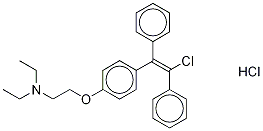Biological Activity
Enclomiphene is a non-steroidal estrogen receptor antagonist th at promotes gonadotropin-dependent testosterone secretion by the testes. Enclomiphene is the trans-isomer of clomiphene, which is about a 60-40 mix of trans (Enclomiphene) and cis (Zuclomiphene). While enclomiphene (trans-clomiphene) is an estrogen antagonist, zuclomiphene (cis-clomiphene) is a mixed agonist, responsible for the estrogenic activity and therefore the common side effects sometimes seen in males. The enclomiphene isomer is responsible for the anti-estrogen activity and the restoration of ones hypothalamic–pituitary–gonadal axis. In recent clinical trials, enclomiphene increased serum LH and FSH with concomitant increases in testosterone in men with secondary hypogonadism. Enclomiphene showed overall better results than testosterone gels, which raise serum testosterone but can lower LH and FSH at the same time.
in vivo
Enclomiphene hydrochloride (subcutaneous injection, 0.25 and 0.5 mg/animal, daily) inhibits spermatogenesis and decreases serum luteinizing hormone (LH) and testosterone levels in intact or castrated rats[5].
Enclomiphene hydrochloride (oral adminstration, 0.03-3 mg/kg, daily for 90 days) reductes body weight to sham levels, and reduced serum cholesterol[6].
| Animal Model: | 21 days-old Charles River male rats[5] |
| Dosage: | 0.25 and 0.5 mg/animal, daily for 24 days. |
| Administration: | Subcutaneous injection |
| Result: | Decreased LH and testosterone levels in the serum. |
| Animal Model: | OVX (ovariectomy) rat model[6] |
| Dosage: | 0.03, 1, and 3 mg/kg, daily for 90 days. |
| Administration: | Oral adminstration |
| Result: | Reducted body weight to sham levels, and reduced serum cholesterol.
Showed dose-dependent effects on the proximal tibia with BMD and BMC approaching posttreatment Sham levels.
|
